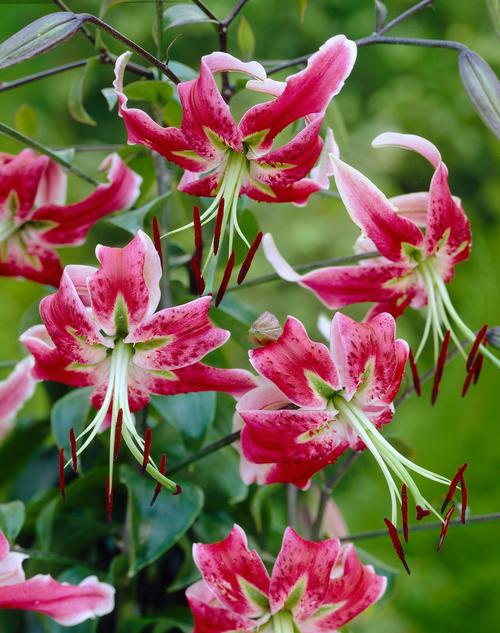ALL ABOUT LILIES
Lilies are hardy, easy-to-grow bulbs that steal the show wherever they’re planted. Other perennials just can’t compete with their big blooms, amazing colors and wonderful fragrance.
There are several types of lilies and each has its own look and bloom time. By planting an assortment of different types of lilies, you can enjoy having these beautiful flowers in bloom all summer long. Shop HERE for lilies.

START WITH A BETTER PLANT
When you compare two lily bulbs side by side, it’s easy to see a difference in quality. Lily bulbs are measured in centimeters. A 16/18 cm bulb (shown on the right) will grow into a stronger plant with more flowers than a smaller, 14/16 bulb (on the left). Longfield Gardens supplies large, 16/18 cm lily bulbs so you can enjoy the biggest, brightest blooms.

PLAN FOR SUCCESS
SHADE AND SUN: Lilies perform best in full sun, though they will also grow in partial shade.
ZONE: In hardiness zones 4-9, lilies are perennial and will survive the winter outdoors. They may be grown as annuals in zone 3 and zones 10-11. Not sure about your growing zone? Find it HERE.
WHEN TO PLANT: Lily bulbs may be planted in early spring or fall. Both planting times will give you flowers in mid to late summer.

WHERE TO PLANT LILIES
PERENNIAL GARDENS: Want to keep your perennial garden looking colorful all summer long? Plant lilies! There are lilies that bloom in early summer, midsummer and late summer. Some of the best lilies for perennial gardens are Asiatics, double Asiatics, LA Hybrids, Trumpets, Oriental lilies and OT Hybrids. Plant Asiatic lilies and the shorter varieties of Oriental lilies toward the front of borders; other types toward the back.
CUTTING GARDENS: Lilies are long lasting cut flowers and many of them will add fragrance as well as beauty to your summer bouquets. Planting lily bulbs in a cutting garden ensures you will have plenty of flowers for bouquets without sacrificing the lilies in your flower gardens. The best lilies for cutting gardens are Asiatics, double Asiatics, LA Hybrids, Orientals and OT Hybrids.
CONTAINER GARDENS: Asiatic and double Asiatic lilies are ideal for pots and planters. Some of the shorter Oriental lilies, such as ‘Stargazer’ are also well suited to containers. For best results, plant lily bulbs in containers that are at least 10” deep.

HOW TO PLANT LILIES
Lilies look best planted in groups of 3 or more bulbs, spaced 6 to 8” apart on center.
Loosen the soil to a depth of 8 to 12” and then dig a 6” deep hole.
Put the lily bulb in the bottom of the hole and cover it with soil. Water only if the soil is dry.
PLANTING TIPS
Most flower bulbs have an outer layer that protects them from moisture loss and damage. Lily bulbs lack a protective coating, so they need to be handled with extra care and planted as soon as possible. If you see blue or green mold on the outer scales, this is normal and no cause for worry.
Lily bulbs are a tasty treat for chipmunks, squirrels and voles. If you have problems with these pests, try planting your lilies a few inches deeper than what’s usually recommended. You’ll find more suggestions in this article: How to Protect Flower Bulbs from Voles.

WHAT TO EXPECT FROM YOUR LILIES
When lilies are planted in a location that suits them, they will usually multiply and come back to bloom again each summer. If you want your lilies to do this, it’s important to not to cut the stems. This is because all of the lily’s foliage is on stem. Without foliage, the bulb can't generate enough energy to produce flowers the following year.
If you want to grow lilies for cutting, they should be treated as annuals. Plant these bulbs in a cutting garden or in nursery pots so you can cut as many stems as you want and compost the bulbs at the end of the season.
Lily bulbs grow best in well drained, fertile soil. During spring and early summer, the plants need moisture, but if the soil is too wet it can rot the bulbs or lead to disease problems. If you're growing lilies in pots, let the top several inches of soil get relatively dry between waterings.
Lilies are tall and slender, so they don’t occupy a lot of space in the garden. But it’s important for their foliage to be exposed to plenty of light – and not be shaded by other plants.

CARING FOR LILIES AFTER THEY BLOOM
As the blossoms fade, snip them off to keep the plants looking neat. You can eventually remove the entire cluster of spent flowers, but leave behind as much stem as possible. Allow the stem and the leaves to continue growing until they turn yellow in late summer or fall. At this point, cut the stems back to within a couple inches of the soil surface.
Lilies are cold hardy in zones 4-9, so the bulbs may be left right in the garden for the entire winter.
Over time, most lily bulbs will multiply and the plants will grow into large clumps with many stems. Lily bulbs don't mind being crowded and it's rarely necessary to divide them.
Learn more here: 8 Tips for Growing Better Lilies; How to Garden with Lilies; How to Control Red Lily Leaf Beetles; Bloom Times for Lilies; Bloom Time Planning Guide for Spring and Summer Flower Bulbs
See our complete selection of lilies HERE.


